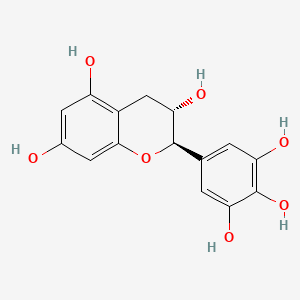| MeSH term | MeSH ID | Detail |
|---|---|---|
| Hemolysis | D006461 | 131 associated lipids |
| Adenocarcinoma | D000230 | 166 associated lipids |
| Lung Neoplasms | D008175 | 171 associated lipids |
| Reperfusion Injury | D015427 | 65 associated lipids |
| Colonic Neoplasms | D003110 | 161 associated lipids |
| Sarcoma 180 | D012510 | 21 associated lipids |
| Body Weight | D001835 | 333 associated lipids |
| Edema | D004487 | 152 associated lipids |
| Precancerous Conditions | D011230 | 48 associated lipids |
| Liver Diseases | D008107 | 31 associated lipids |
Gallocatechin
(+)-gallocatechin is a lipid of Polyketides (PK) class. The involved functions are known as inhibitors and Cell Survival. The associated genes with (+)-Gallocatechin are TERT gene.
Cross Reference
Introduction
To understand associated biological information of Gallocatechin, we collected biological information of abnormalities, associated pathways, cellular/molecular locations, biological functions, related genes/proteins, lipids and common seen animal/experimental models with organized paragraphs from literatures.
What diseases are associated with Gallocatechin?
Gallocatechin is suspected in Hyperinsulinism, nervous system disorder, Obesity, Parkinson Disease, Transient ischemia and other diseases in descending order of the highest number of associated sentences.
Related references are mostly published in these journals:
| Disease | Cross reference | Weighted score | Related literature |
|---|
Possible diseases from mapped MeSH terms on references
We collected disease MeSH terms mapped to the references associated with Gallocatechin
PubChem Associated disorders and diseases
What pathways are associated with Gallocatechin
There are no associated biomedical information in the current reference collection.
PubChem Biomolecular Interactions and Pathways
Link to PubChem Biomolecular Interactions and PathwaysWhat cellular locations are associated with Gallocatechin?
Visualization in cellular structure
Associated locations are in red color. Not associated locations are in black.
Related references are published most in these journals:
| Location | Cross reference | Weighted score | Related literatures |
|---|
What functions are associated with Gallocatechin?
Related references are published most in these journals:
| Function | Cross reference | Weighted score | Related literatures |
|---|
What lipids are associated with Gallocatechin?
Related references are published most in these journals:
| Lipid concept | Cross reference | Weighted score | Related literatures |
|---|
What genes are associated with Gallocatechin?
Related references are published most in these journals:
- Drug Metab. Dispos. (4)
- Cancer Epidemiol. Biomarkers Prev. (2)
- Am. J. Physiol., Cell Physiol. (1)
- Others (7)
| Gene | Cross reference | Weighted score | Related literatures |
|---|
What common seen animal models are associated with Gallocatechin?
Transgenic Model
Transgenic Model are used in the study 'Dietary (-)-epicatechin as a potent inhibitor of βγ-secretase amyloid precursor protein processing.' (Cox CJ et al., 2015).
Rodent Model
Rodent Model are used in the study 'Dietary (-)-epicatechin as a potent inhibitor of βγ-secretase amyloid precursor protein processing.' (Cox CJ et al., 2015).
Related references are published most in these journals:
| Model | Cross reference | Weighted score | Related literatures |
|---|
NCBI Entrez Crosslinks
All references with Gallocatechin
Download all related citations| Authors | Title | Published | Journal | PubMed Link |
|---|---|---|---|---|
| Fathima A and Rao JR | Selective toxicity of Catechin-a natural flavonoid towards bacteria. | 2016 | Appl. Microbiol. Biotechnol. | pmid:27052380 |
| Zhang YN et al. | Improving the sweet aftertaste of green tea infusion with tannase. | 2016 | Food Chem | pmid:26304374 |
| Unno K et al. | Anti-stress effects of drinking green tea with lowered caffeine and enriched theanine, epigallocatechin and arginine on psychosocial stress induced adrenal hypertrophy in mice. | 2016 | Phytomedicine | pmid:27765356 |
| Nowak A et al. | Polyphenolic extracts of cherry (Prunus cerasus L.) and blackcurrant (Ribes nigrum L.) leaves as natural preservatives in meat products. | 2016 | Food Microbiol. | pmid:27375255 |
| Mendoza-Sánchez M et al. | Effect of chemical stress on germination of cv Dalia bean (Phaseolus vularis L.) as an alternative to increase antioxidant and nutraceutical compounds in sprouts. | 2016 | Food Chem | pmid:27374516 |
| Santos SA et al. | Profiling of lipophilic and phenolic phytochemicals of four cultivars from cherimoya (Annona cherimola Mill.). | 2016 | Food Chem | pmid:27283704 |
| Wein S et al. | Systemic Absorption of Catechins after Intraruminal or Intraduodenal Application of a Green Tea Extract in Cows. | 2016 | PLoS ONE | pmid:27427946 |
| Wang L et al. | Functional Characterization of a Dihydroflavanol 4-Reductase from the Fiber of Upland Cotton (Gossypium hirsutum). | 2016 | Molecules | pmid:26821011 |
| Abourashed EA et al. | Content Variation of Catechin Markers, Total Phenolics and Caffeine in Green Tea Dietary Supplements. | 2016 | J Diet Suppl | pmid:25299974 |
| Liu Z et al. | Synergistic Effects of Potentilla fruticosa L. Leaves Combined with Green Tea Polyphenols in a Variety of Oxidation Systems. | 2016 | J. Food Sci. | pmid:27061936 |
